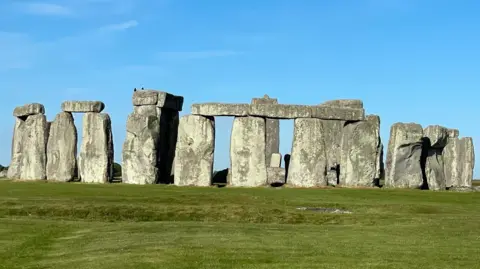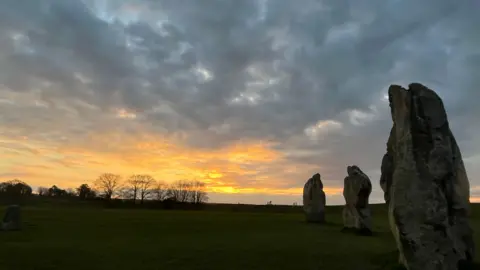The 150 page document that aims to help protect Stonehenge
 BBC
BBCThe Stonehenge World Heritage Site is big - so big, it is actually split in two, with much of it around Avebury.
People have lived and worked in the area long before they were ever declared a World Heritage Site - so when someone needs to build something, how do you make sure it will not negatively affect the much loved sites?
That is where a new draft document of more than 150 A4 pages comes in.
Officially labelled a "supplementary planning document", Wiltshire Council's cabinet member for environment, Paul Sample JP, called it an "important draft document that will help protect an historic and vital part of our heritage".
It would act as guidance to people wanting to undertake any development - whether a small garden extension or a solar farm - and those making the final decisions.
However, as it is only a draft at the moment, Wiltshire Council has it open for consultation and wants to hear from the public.

Mr Sample JP said: "At Stonehenge and Avebury we have inherited one of the most important landscapes in the world.
"It's essential that there is clear guidance so that any planning decisions affecting the World Heritage Site do not impact it adversely."
It explains what needs to be taken into account and shows if there are extra assessments that need to be done to make sure a project will not impact the area negatively.

There are some considerations that you would not usually expect to find in a planning document.
For example, it discusses astronomy. That is because not only Stonehenge, but a few of the monuments - including Woodhenge and Durrington Walls - are shown to have alignments to solstices and lunar movements.
"We know Stonehenge was used as a kind of sun calendar," explained Melanie Pomeroy-Kellinger, who is a manager for archaeology, landscape and historic environment at Wiltshire Council.
"We can't allow a massive development on the line of midsummer solstice for example. That would interfere with people's enjoyment and understanding of the importance of those alignments."
Any development that is too tall for example, might affect the view, give off too much light pollution or reflections that could affect the sites.

It also talks about views in the area and how monuments connect to each other, some very obviously, like avenues and ridges.
"It's really important to think about it as ceremonial landscape," said Claire Selman, also a member of the team working with the council.
"They might have been designed to be visible from one another" she added, mentioning that many also have connections to rivers.
Trees and woodland are also mentioned - some in a positive light, but it also notes the fact that some already in the area do not fit, with one in particular affecting the winter solstice.
George Downs, who also works with the council, explained that while they are looking to introduce the Supplementary Planning Document, it does not mean there was nothing in place before.
The document integrates UNESCO Guidance on Heritage Impact Assessments and advice from Historic England with the National Planning Policy Framework and Local Plan requirements.
"There is a World Heritage Site Partnership which has had a management plan for the site which we last compiled in 2015," he said.
"It has an action plan which is reviewed every year."
But this new document would give extra information and detail which, if adopted, will be used to ensure that any developments do not adversely impact the internationally significant monuments.

The Supplementary Planning Document was created between the council, Chris Blandford Associates and has had input from the World Heritage Site Partnership.
People can comment on the consultation online until 17 June, when there is also a recorded webinar to watch.
There are also two more drop-in events to speak to people face-to-face being held at Amesbury Library on Monday 9 June and Marlborough Library on 12 June, both from 16:00 BST until 19:00 BST.
Once the council has been through the comments, it will consider the final version in October.
Follow BBC Wiltshire on Facebook, X and Instagram. Send your story ideas to us on email or via WhatsApp on 0800 313 4630.
